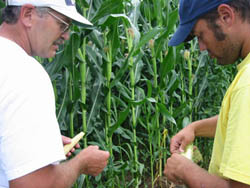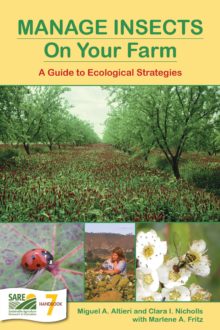
Farm Feature: Diversity In Every Field And Pen
- Diversifies crops within space and time
- Plants windbreaks and grassy field borders
- Integrates crop and livestock operations
- Builds soils with diverse organic mattern uses resistant crops
It's been two decades since Ron and Maria Rosmann began transitioning their west central Iowa farm to organic. Their crops — soybeans, corn, alfalfa, turnips, grasses, oats, rye and other small grains — were certified organic in 1994. Their 90 stock cows and 650 broiler chickens followed in 1997, while their 20 antibiotic-free Berkshire sows are “natural pork.”
Except for seed staining in their soybeans — transmitted by bean leaf beetles — and aphids and leafhoppers in their alfalfa, Rosmann Family Farms are bothered by few pests. While most of their neighbors have readily switched to “biotech” varieties, the Rosmanns’ corn and soybean yields, over a 20-year average, are at least as high as the county’s.
“Things are working well here and there’s got to be a reason — and it’s not just one,” says Rosmann. “We look at it as a whole system.”
Biodiversity is hard at work above and below ground
On their fourth-generation farm near Harlan, the Rosmanns plant windbreaks, grassy field borders and — for pheasants and quail — native prairie species. Generous populations of lacewings and ladybugs indicate that the Rosmanns’ commitment to biodiversity is keeping predators in balance with prey. Nesting boxes support three pairs of American kestrels, which return the favor by snatching up small rodents.
Rather than alternating corn and soybeans every other year, the Rosmanns’ primary rotation spans six years: corn, soybeans, corn, small grains and two years of alfalfa. Instead of expansive monocultures, they break up their 620 acres into about 45 fields, letting topography decide how each field is divided. If their light infestations of corn borers drop a few ears of corn onto the ground, their cattle glean them after harvest. “Most conventional farmers continue to tear out their fences,” says Rosmann. “They don’t have anything running on their fields to pick up the fallen grain. It’s wasted on most farms. That’s ridiculous.”
Livestock enrich soils
If he had to offer just one reason why his farming system is so resilient, Rosmann would say it’s his healthy soils. He beds his livestock in oat, rye and barley straw — his hogs are treated to the Swedish deep-bedding system of 2-foot-thick straw — then composts the straw with their manure. He feeds his soils every cubic inch of that compost and tills his fields very minimally. For example, he plants his corn and soybeans into ridges and turns those fields under only after the rotation’s third year.
“I think our soil biology is balanced and that the bacteria, fungi and other microorganisms really help us out,” he says. “They must be helping our productivity and breaking our disease and insect cycles.”
Indeed, the Rosmanns have only used one insecticide in their corn and soybeans in the past 20 years — Bacillus thuringiensis (Bt) against corn borers — but the insects didn’t affect yields that year anyway and the Rosmanns haven’t used the product since. “We try to keep our input costs down. As long as our yields are not being compromised, why purchase inputs?” he asks.
Rosmann controls the aphids and leafhoppers in his alfalfa by harvesting earlier when possible. That decreases production, but he can “put up with it.” He also plants orchard grass with alfalfa, which discourages some pests.
Besides soil health, the Rosmanns control crop diseases with resistant varieties. They shop aggressively for disease resistance, but they’re becoming discouraged. No resistance is currently available to prevent the beetle-transmitted seed staining that sometimes sends their soybeans to feed markets rather than to Japanese tofu buyers. “There’s very little public plant breeding going on right now,” says Rosmann. “The interest is in biotechnology and that’s where the dollars are going, sad to say.”
His ridge-tilled fields are much cleaner than conventionally tilled fields, with only one-seventh to one-tenth as many weeds. Early tillage, rotary hoeing after planting and cultivation destroy most of the weeds in Rosmann’s other fields. The rest of his weeds he simply lives with, peaceably and profitably.
Abundant small fields foster diverse practices
Rosmann Family Farms has several advantages many other farms don’t: although they used pesticides for about 10 years during the 1960s and 1970s, the family never abandoned its mixed crop-livestock approach nor its generous crop rotations. In addition, the Rosmanns’ 600-plus acres give them exceptional flexibility — and protection. “We have such a diversity of fields in different locations that we generally don’t have problems in all of our fields at once — just a portion of a field.”
The Rosmanns’ practices are as diverse as their crops. They rotate some of their crop fields into grass-legume pastures, especially if those fields are building up unacceptable levels of weeds. They use cover crops in the corn they plant for silage but not in other corn fields. They rotate their grazing as well as their crops, thereby improving their pasture productivity and pest control. To provide feed for their cattle from mid-September until late fall, when corn stalks become available, they also follow barley and oats with turnips, rye and hairy vetch in mid-July.
The Rosmanns have been evaluating their individual practices with on-farm research trials for 15 years. They know what contributes to yield improvements and what doesn’t but they haven’t precisely pinpointed cause and effect — or whether interactions, rather than discrete practices, produce crop and soil benefits.
“There’s no doubt, absolutely no doubt, that our approach is better for the environment and for us,” Rosmann says. “But we just plain need research — on-farm systems research — to answer questions on farms like ours.”
